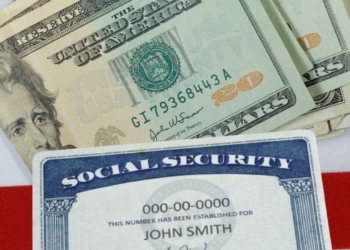An analysis by the Office of the Chief Actuary of Social Security projects that retirement and survivors beneficiaries could face cuts in their payments starting in 2032. Some might lose thousands of dollars every year, if this tough scenario happens.
The Old-Age and Survivors Insurance (OASI) Trust Fund, which supports these benefits, could exhaust its reserves by the fourth quarter of 2032, according to the assessment requested by Senator Ron Wyden. This temporary advance—relative to the previous projection for the first quarter of 2033—is attributed to the One Big, Beautiful Bill Act (OBBBA), a law enacted the month prior to the study.
Retirees May Only Receive 81% of Promised Benefits
Chief Actuary Karen Glenn warned in an official communication that the tax provisions of this legislation will reduce the funds’ revenues. “Given that income tax revenues from Social Security benefits are allocated to the trust funds […] the implementation of the OBBBA will have a material effect on the financial condition of the Social Security trust funds,” she detailed in a letter to Wyden. The critical mechanism is an enhanced tax deduction for seniors that will reduce tax collections on benefits.
If the fund is depleted, the current 70 million beneficiaries would receive only 81% of the assigned amounts. This 19% reduction would be applied when the combined OASI-DI fund reaches its insolvency point, currently projected for the first quarter of 2034 — three quarters earlier than previously estimated. Actuarial models indicate that current revenues would only cover four-fifths of the total obligations.
The Boards of Trustees’ report (June 2025) had already confirmed this scenario of automatic cuts, but the new analysis brings forward their possible start. Glenn emphasized that the “combined net effect” of the OBBBA will generate “lower overall tax liability for beneficiaries” but will simultaneously cause “trust funds to receive lower projected income levels […] for all years beginning in 2025.” This duality means immediate tax relief for retirees, but an accelerated risk of future reductions in their payments.
Social Security benefit cuts inevitable without reform
While the OASI fund shows accelerated vulnerability, the Disability Fund (DI) remains stable over the 75-year horizon. This disparity implies that pension and survivor benefits would face cuts first. The continued existence of tax brackets from the 2017 reform—another provision of the OBBBA—intensifies the pressure on the pension fund by reducing sustained income.
The analysis does not speculate on political solutions, limiting itself to quantifying impacts. The 70 million benefit recipients—the figure officially reported in June 2025—constitute the population exposed to this actuarial risk. The projection assumes no legislative changes that would alter the current trajectory of the funds.
What are the maximum Social Security benefits in 2025?
In 2025, if a person decides to begin receiving Social Security benefits at the minimum age of 62, the maximum monthly amount they can receive is approximately $2,831. This represents a reduction of nearly 30% compared to the full benefit, since the claim is filed before full retirement age.
On the other hand, those who wait until they reach the so-called “full retirement age” (FRA)—which for those who turn 62 in 2025 is 67—can receive up to a maximum of $4,018 per month. In this case, the benefit is not reduced, but they also do not receive additional increases for delaying their claim beyond that age.
Finally, those who postpone the start of payments until age 70 can access the maximum benefit available in 2025, which amounts to $5,108 per month. This increase is due to delayed retirement credits, which increase the amount by approximately 8% for each additional year after full retirement age.







